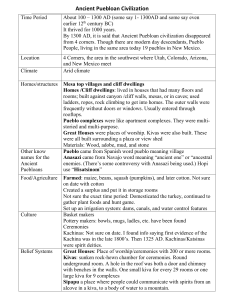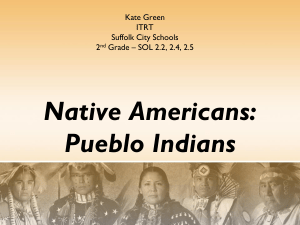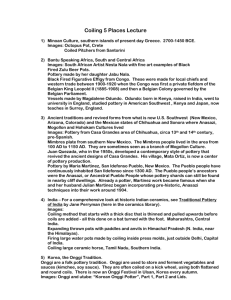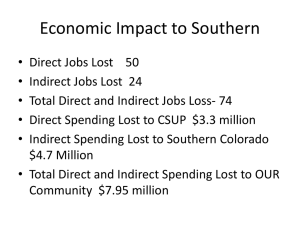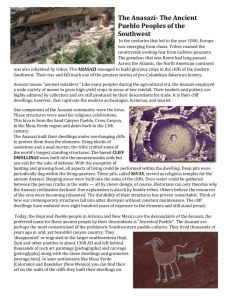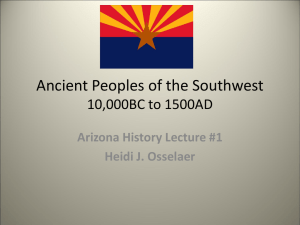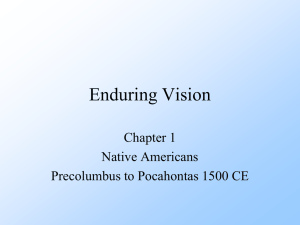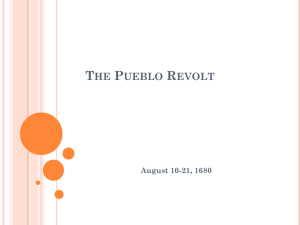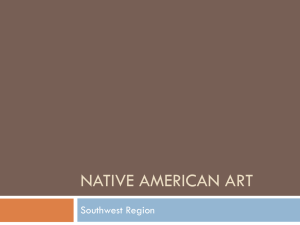The Pueblos : Timeline and Paragraph
advertisement
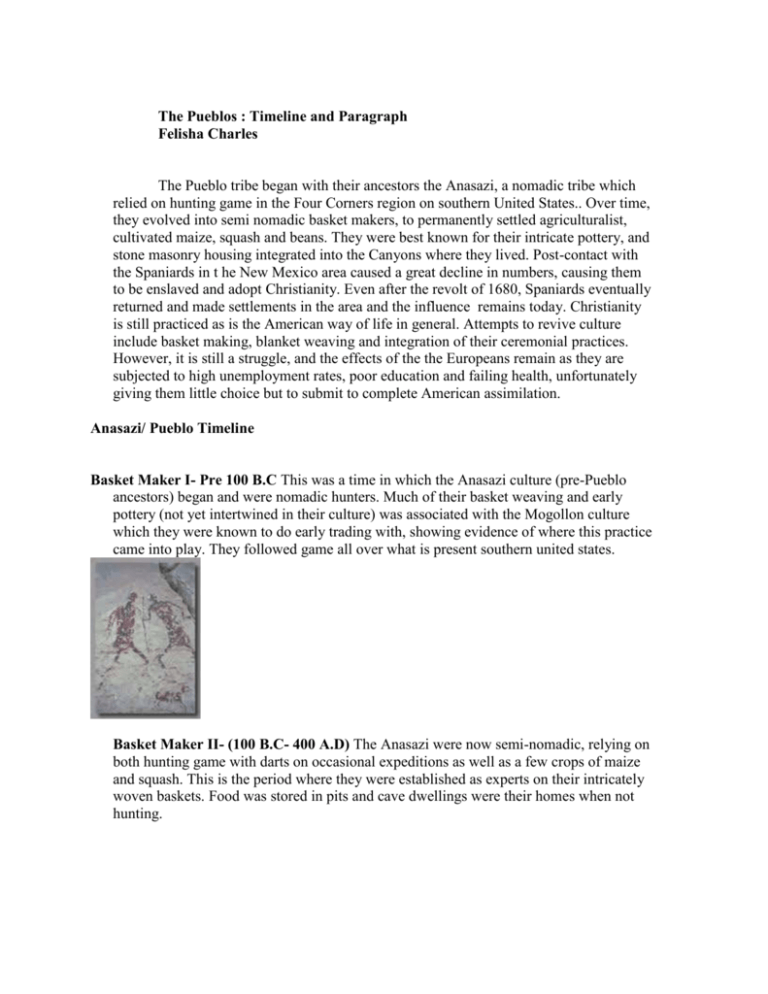
The Pueblos : Timeline and Paragraph Felisha Charles The Pueblo tribe began with their ancestors the Anasazi, a nomadic tribe which relied on hunting game in the Four Corners region on southern United States.. Over time, they evolved into semi nomadic basket makers, to permanently settled agriculturalist, cultivated maize, squash and beans. They were best known for their intricate pottery, and stone masonry housing integrated into the Canyons where they lived. Post-contact with the Spaniards in t he New Mexico area caused a great decline in numbers, causing them to be enslaved and adopt Christianity. Even after the revolt of 1680, Spaniards eventually returned and made settlements in the area and the influence remains today. Christianity is still practiced as is the American way of life in general. Attempts to revive culture include basket making, blanket weaving and integration of their ceremonial practices. However, it is still a struggle, and the effects of the the Europeans remain as they are subjected to high unemployment rates, poor education and failing health, unfortunately giving them little choice but to submit to complete American assimilation. Anasazi/ Pueblo Timeline Basket Maker I- Pre 100 B.C This was a time in which the Anasazi culture (pre-Pueblo ancestors) began and were nomadic hunters. Much of their basket weaving and early pottery (not yet intertwined in their culture) was associated with the Mogollon culture which they were known to do early trading with, showing evidence of where this practice came into play. They followed game all over what is present southern united states. Basket Maker II- (100 B.C- 400 A.D) The Anasazi were now semi-nomadic, relying on both hunting game with darts on occasional expeditions as well as a few crops of maize and squash. This is the period where they were established as experts on their intricately woven baskets. Food was stored in pits and cave dwellings were their homes when not hunting. Basket Maker III ( 400 a.d- 700 a.d ) Homes began to evolve, now had pit/mud houses houses in shallow caves. Agriculture consisted of squash, maize and now beans, as agriculture was their main reliance, causing them to eventually permanently settle. Tools were more sufficient and better spears had been crafted from wood and stone. Pueblo I and II ( 700 a.d- 110 a.d) This is the age where the Anasazi descendants, the Pueblos first began. The territory was expanded, and a whole new level of housing was introduced as they began stone masonry and were able to carve homes into canyons and had entire villages atop the canyons as they now built homes above the ground rather than pits. Cotton was also introduced, and the pottery they are known for was classified as culinary, or the more artistic black and white decorated wares for ceremonies. Old pit houses were now used for ceremonial burial grounds. Peublo III ( 1100-1300) The Peublo artistry reached its peak, as pottery designs became more intricate, colors ranged from blacks, white to more colorful orange, red and brown hues.Immense dwellings were made in the Mesa Verde. Pueblo V (1600 a.d +) After the drought, the Pueblos relocated to a water drainage basin at the Rio Grande, New Mexico. This is also the point where there was first contact with Spaniards, where they were conquered and forced into slave work and subjugated. There was a revolt in 1680 eventually driving away the oppressors. 1692- Diago De Vargas, came back and implement Spanish settlements among the Pueblos. The Pueblos were forced to follow the belief systems of the Spanish. Today- The Remaining Pueblos are situated in the New Mexico area, assimilated into American culture for the most part including religion. However, many dedicated to preserving culture still trade, make blankets, and baskets and even integrate their kiva art from into present day churches. Research Organizer Works Cited Page Information Author’s Name: Jaqueline Peppard Publisher’s Name: Pueblo Indian.com Date Published: October 17, 2002 Date accessed: July 10, 2011 URL: http://www.puebloindian.com/pueblo_history_001.htm Tribe Name: Geographic Location Pre Contact/Traditional Post Contact/Today Settled in S.E Colorado New-Mexico Utah Arizona Driven to New Mexico due to droughts in four corners region Language Tanoan, Keresan, Hopi, and Uto-Aztecan Dialects (each spoken within various Pueblo tribes) Keresan, Tanoan, Hopi, Tewa, Tiwa, Towa (main Language Groups, in addition to discrete dialects. Political Organization Ancestors called Anasazi, Follow under United were nomadic hunters who States Laws/Regulations; eventually came to settle practice ancestral ways in four corners region. discreetly. Each Pueblo village was divided into clans, each had own space for farming, housing etc.. Was an Egalitarian society; equal rights for each tribe member. Members rotated and took turns in the decision making of Pueblo government. Decline in empire during 14th century, unknown reasons, speculation of invasion, drought and cannibalism. Customs (marriage, childbirth, funerary, religion) Food offerings made to gods by male of Follow Chirstianity openly as they were assimilated Lifestyle (clothes, food, transportation, shelter, village organization, roles of children, women, men etc.) household, thrown in fire. Had various gods. Society was matrilineal. Marriages were made for females and males of separate clans. Were first nomadic, then sedentary. (huntersgatherers) a.d 700;Known for vast homes, pottery & basket weaving. “pueblo” meaning, stone masonry village dweller. Had dry hot climate, so t hey raised turkeys and grew corn, squash and beans. Main meals were bread and stew, ate twice a day. Farming tools of stone and wood, some of which were quite sophisticated. Homes made in canyons (caves) expertly done by stone masons, and adorned with various mud/clay of red and brown hues. Looked very much like apartments. Men wove baskets,women inherit homes, own houses. Works Cited Page Information Research Organizer Works Cited Page Information Author’s Name: Linda Cordell Publisher’s Name: Scholastic Inc. & Groiler Online Date Published: Date accessed: July 11th, 2010 URL: http://www2.scholastic.com/browse/article.jsp?id=5042 but still practice old cultural traditions in secret Assimilation to American culture for the most part. Many churches/chapels use same elements as kivas. Eg, St. Augustine Church -Economy runs by trade - blankets and baskets pop. Among tourists -high unemployment rate, poor education, causing culture to erode Tribe Name: Anasazi/ Pueblo Tribe Name: Geographic Location Pre Contact/Traditional Post Contact/Today “” Previously documented “” Language “” Political Organization Still in clans and have equal rights, also required to follow laws of the US Customs (marriage, childbirth, funerary, religion) Dead bodies were buried in pit/ sepulchers with monumental belongings. Pit houses (kivas) used as ceremonial meeting grounds Lifestyle (clothes, food, transportation, shelter, village organization, roles of children, women, men etc.) Furthest origins show similarity with Mogollon culture, (100 b.c to 1400 a.d) , as they began ceramics and settled argriculture. Evidence of trade w/ Anasazi & Mogollon Eight Phases: Basket Maker 1 (Archaic): Nomadic, hunt& gathered Basket Maker 2 (100 b.b400 a.d) Became known for intricate woven baskets. Clothes: short skirts for women, thong like for men. Were Semi-nomadic. Used darts and small spears to hunt small game. Animals caught with nets as well. Lived in caves. Started growin mazie/squash and occasion hunting expeditions. Stored food in pits. Many baskets, bags & sandals still survived today. Basket Maker III ( 400 a.d700 a.d ) Now had pit/mud houses houses in shallow caves. Agriculture included beans. Bows and arrows soon turned to large more sufficient spears. Relied more on agriculture which led to more permanent settling. Pueblo I and II ( 700 a.d110 a.d) –expanded territory -intro of cotton and masonry -had above ground housing -villages atop canyons -2 pottery types: culinary & decorated wares -decorated had black/white designs Peublo III ( 1100-1300) -art developed to its climax - pottery made elaborate & now included orange & red coloring -huge stone masonry apartments/dwellings still seen at Mesa Verde Pueblo IV (1300-1600 a.d) Decline of Pueblo due to some raids, conflicts among Pueblos and mainly drought/ famine -moved to Rio Grande, New Mexico (water source) Pueblo V (1600 a.d +) Includes first contact with SPaniards
